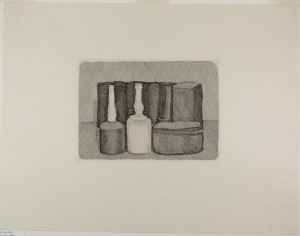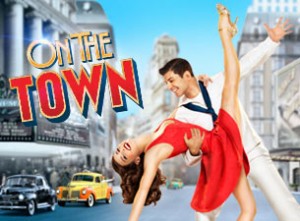 “He is a self-styled public-relations counselor—one of the various modern activities that are an insult to the dignity of man.”
“He is a self-styled public-relations counselor—one of the various modern activities that are an insult to the dignity of man.”
Rex Stout, The Father Hunt
Terry Teachout on the arts in New York City
I spent much of last week in West Palm Beach, where I saw a show, gave two talks, and paid a quick visit to the Norton Museum of Art, which has mounted an unassuming yet noteworthy exhibition of forty works on paper called Master Prints: Dürer to Matisse. The prints, all of which are owned by discreetly anonymous lenders, were well chosen—I’ve never seen so many first-class Rembrandt etchings in a single gallery—and in immaculate condition.
 I was especially interested in a 1954 etching by Giorgio Morandi that I’d only seen reproduced in catalogues. You can’t fully appreciate the texture and depth of a great etching until you see it “in the flesh,” so to speak, and this one ranks among Morandi’s finest. Having once tried and failed to buy a Morandi etching at auction, I was briefly incapacitated by envy of the unknown owner, but I soon got over it and marveled at the quiet beauty of “Still Life with Nine Objects.”
I was especially interested in a 1954 etching by Giorgio Morandi that I’d only seen reproduced in catalogues. You can’t fully appreciate the texture and depth of a great etching until you see it “in the flesh,” so to speak, and this one ranks among Morandi’s finest. Having once tried and failed to buy a Morandi etching at auction, I was briefly incapacitated by envy of the unknown owner, but I soon got over it and marveled at the quiet beauty of “Still Life with Nine Objects.”
To quote what I wrote in the Washington Post ten years ago about an exceptionally impressive Morandi exhibition:
The effect of this show is wildly disproprtionate to its minuscule size: six oil paintings and two works on paper, all of them still lifes and none in any obvious way imposing. Yet as you look at how the greatest Italian artist of the 20th century painstakingly arranged and rearranged a dozen bottles, bowls and boxes on a table and painted them over and over again, you find yourself whisked out of the grinding noise of everyday urban life and spirited away to a place of intense stillness. It’s as if a soft-spoken man had slipped discreetly into a small room open to the public, whispering life-changing confidences to the fortunate few who visit him there.
 One of the reasons why I wanted to see Master Prints: Dürer to Matisse is that Mrs. T and I also collect prints, albeit on a far more modest scale. The day after I flew back to New York, I picked up our newly framed copy of Childe Hassam’s “Storm King” and brought it home. I’d originally planned to hang it directly above John Twachtman’s “Dock at Newport,” but Mrs. T, who has a sharp eye, gave me a better idea, and so “Storm King” now shares a wall with “Storm Over Manhattan,” a 1936 lithograph by Louis Lozowick (reproduced at right) for which she has a special liking.
One of the reasons why I wanted to see Master Prints: Dürer to Matisse is that Mrs. T and I also collect prints, albeit on a far more modest scale. The day after I flew back to New York, I picked up our newly framed copy of Childe Hassam’s “Storm King” and brought it home. I’d originally planned to hang it directly above John Twachtman’s “Dock at Newport,” but Mrs. T, who has a sharp eye, gave me a better idea, and so “Storm King” now shares a wall with “Storm Over Manhattan,” a 1936 lithograph by Louis Lozowick (reproduced at right) for which she has a special liking.
On Sunday I read an essay about materialism in which Arthur Brooks made the following observation:
In the realm of material things, attachment results in envy and avarice. Getting beyond these snares is critical to life satisfaction. But how to do it?…
First, collect experiences, not things.
Material things appear to be permanent, while experiences seem evanescent and likely to be forgotten. Should you take a second honeymoon with your spouse, or get a new couch? The week away sounds great, but hey—the couch is something you’ll have forever, right?
Wrong. Thirty years from now, when you are sitting in rocking chairs on the porch, you’ll remember your second honeymoon in great detail. But are you likely to say to one another, “Remember that awesome couch?” Of course not. It will be gone and forgotten. Though it seems counterintuitive, it is physically permanent stuff that evaporates from our minds. It is memories in the ether of our consciousness that last a lifetime, there for us to enjoy again and again.
Of course I see what Brooks is getting at, and up to a point I agree with him (though I’d be more inclined to take his reflections on the problem of materialism seriously had he not gone well out of his way to explain how they were inspired by “a recent trip to India”). Over the weekend Mrs. T and I went to Ecce Bed and Breakfast, the rural retreat where we spent our honeymoon, and we expect that both of those blissful experiences will last us a lifetime. On the other hand, Arthur Brooks also sounds like the kind of person who’s never really looked at a painting. Buying an awesome lithograph is not the same thing as buying an awesome couch. Sometimes things are experiences.
 In 2004, a year after I started buying works on paper, I wrote an essay for Commentary in which I described the experience of living with art:
In 2004, a year after I started buying works on paper, I wrote an essay for Commentary in which I described the experience of living with art:
Whatever my reservations—and no collector is ever entirely satisfied—I am happy with the Teachout Museum just as it is. Not only is it a joy to behold, but its beauties have had the beneficial effect of making me want to spend less time rattling around Manhattan, fulfilling the hectic duties of a freelance critic, and more time sitting in my living room, communing with the works of art I have so carefully assembled. Whether it will help me to live longer is an open question, but collecting art, even on a modest scale, has definitely made my interior life richer than ever before.
While the Teachout Museum has doubled in size since I wrote “Living With Art,” my feelings about it remain unchanged. I would never dream of pretending that it’s a bigger deal than it is, but when I returned to our apartment after freshening my eye by spending an afternoon looking at Master Prints: Dürer to Matisse, I felt quite proud of our little collection. Yes, Mrs. T and I put it together on a shoestring, but it was assembled with painstaking thought and much love, and I can’t imagine anyone getting more life-changing pleasure out of the art on their walls than we do from ours. If this be materialism, make the most of it.
 “Two on the Aisle,” a 1974 episode of The Odd Couple written by Mark Rothman and Lowell Ganz and directed by Jay Sandrich. In addition to Tony Randall and Jack Klugman, the cast includes John Simon, who plays himself:
“Two on the Aisle,” a 1974 episode of The Odd Couple written by Mark Rothman and Lowell Ganz and directed by Jay Sandrich. In addition to Tony Randall and Jack Klugman, the cast includes John Simon, who plays himself:
(This is the latest in a series of arts-related videos that appear in this space each Monday and Wednesday.)
In today’s Wall Street Journal drama column I have enthusiastic words for the Broadway revival of The Elephant Man. Here’s an excerpt.
* * *
First “Side Show,” now “The Elephant Man”: This would seem to be Broadway’s Year of the Circus Freak. But while “Side Show” is a slick, sentimental musical that uses the story of a famous pair of conjoined twins to preach a progressive sermon about how it’s O.K. to be different, Bernard Pomerance’s 1977 play about a congenitally deformed man whom Victorian England clasped to its collective bosom is a vastly more serious affair. Scott Ellis’ new production, which originated at the Williamstown Theatre Festival, is the play’s second Broadway revival, and while it wouldn’t have happened were it not for the remunerative presence of Bradley Cooper, the Sexiest Man Alive, it’s worth seeing anyway. Not only is Mr. Ellis’ staging distinguished, but “The Elephant Man” itself is by no means a mere tour de force for a good-looking actor.…
 “The Elephant Man” is a fictionalized recounting of the life of Joseph Merrick (Mr. Cooper), who suffered from a rare condition that caused his skin to resemble the hide of an elephant and distorted his body in other horrifically unsightly ways. Spurned by his family, he spent four years in a workhouse, then submitted to being put on exhibition by crooked showmen. He was rescued by Frederick Treves (Alessandro Nivola), a surgeon who took him into the London Hospital and looked after him for the rest of his brief life. When Dr. Treves made a public appeal to raise funds for his care, the young man became a cause célèbre and drew the attention of England’s high society, for even though he was grotesquely disfigured, his mind functioned normally and he was emotionally sensitive.
“The Elephant Man” is a fictionalized recounting of the life of Joseph Merrick (Mr. Cooper), who suffered from a rare condition that caused his skin to resemble the hide of an elephant and distorted his body in other horrifically unsightly ways. Spurned by his family, he spent four years in a workhouse, then submitted to being put on exhibition by crooked showmen. He was rescued by Frederick Treves (Alessandro Nivola), a surgeon who took him into the London Hospital and looked after him for the rest of his brief life. When Dr. Treves made a public appeal to raise funds for his care, the young man became a cause célèbre and drew the attention of England’s high society, for even though he was grotesquely disfigured, his mind functioned normally and he was emotionally sensitive.
Mr. Pomerance has turned his tale into a parable modeled on “Pygmalion.” Just as Henry Higgins, Shaw’s haughty professor of phonetics, endeavors to turn the grubby Eliza Doolittle into a “real lady,” so does the fictional Dr. Treves school the fictional Merrick in the priggish ways of middle-class respectability, revealing in the process that his own values are as false as the Christianity in which he feigns faith. (Merrick: “If your mercy is so cruel, what do you have for justice?” Treves: “I am sorry. It is just the way things are.”) That’s the point of “The Elephant Man,” whose author, like Shaw before him, holds conventional morality in contempt, going so far as to imply that Merrick might have been better off had he not fallen into the hands of a Victorian hypocrite like Treves.
While such notions are as fashionable today as they were in 1977, I take leave to doubt that any of the real people portrayed in “The Elephant Man,” least of all Merrick, subscribed to them. Nevertheless, Mr. Pomerance has used them as the basis for a play that is extremely smart, if sometimes heavy-handed….
Mr. Cooper, despite his relative lack of stage experience, proves to be a very good actor, one so fully submerged in his part that the audience at the preview I attended didn’t applaud his first entrance, immediately recognizable though he was. His performance is simple, direct and convincing in every way….
* * *
Read the whole thing here.
Here’s my list of recommended Broadway, off-Broadway, and out-of-town shows, updated weekly. In all cases, I gave these shows favorable reviews (if sometimes qualifiedly so) in The Wall Street Journal when they opened. For more information, click on the title.
BROADWAY:
• A Gentleman’s Guide to Love & Murder (musical, PG-13, nearly all performances sold out last week, reviewed here)
• Matilda (musical, G, all performances sold out last week, reviewed here)
• Les Misérables (musical, G, too long and complicated for young children, reviewed here)
 • On the Town (musical, G, contains double entendres that will not be intelligible to children, reviewed here)
• On the Town (musical, G, contains double entendres that will not be intelligible to children, reviewed here)
OFF BROADWAY:
• The Fantasticks (musical, G, suitable for children capable of enjoying a love story, reviewed here)
CLOSING SOON ON BROADWAY:
• Cabaret (musical, PG-13/R, all performances sold out last week, closes Jan. 4, reviewed here)
• Once (musical, G/PG-13, closes Jan. 4, reviewed here)
• This Is Our Youth (drama, PG-13, closes Jan. 4, reviewed here)
CLOSING NEXT WEEK OFF BROADWAY:
• The Seagull and Sense and Sensibility (drama, PG-13, playing in alternating repertory, closes Dec. 21, reviewed here)
CLOSING SUNDAY IN RED BANK, N.J.:
• Camelot (musical, PG-13, reviewed here)
CLOSING SUNDAY OFF BROADWAY:
• Our Lady of Kibeho (drama, PG-13, reviewed here)
CLOSING SUNDAY ON BROADWAY:
• Love Letters (drama, PG-13, reviewed here)
| M | T | W | T | F | S | S |
|---|---|---|---|---|---|---|
| 1 | 2 | 3 | 4 | 5 | 6 | |
| 7 | 8 | 9 | 10 | 11 | 12 | 13 |
| 14 | 15 | 16 | 17 | 18 | 19 | 20 |
| 21 | 22 | 23 | 24 | 25 | 26 | 27 |
| 28 | 29 | 30 | ||||
An ArtsJournal Blog